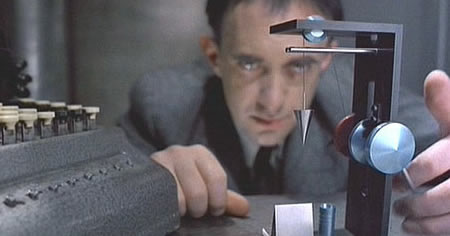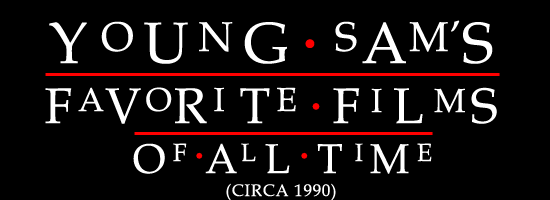No. 3: BRAZIL

Reviewed by Sam Hatch
AS THIS IS PART OF A RETRO NOSTALGIA BINGE AS OPPOSED TO A TRADITIONAL REVIEW, THERE MAY BE SPOILERS PRESENT IN THE TEXT.
I was a fan of Terry Gilliam before I knew it. By the time Brazil had hit theaters I had already fallen in love with the Monty Python films and his twisted children's adventure Time Bandits. The latter was actually one of the first moments when I felt my own taste as a film enthusiast coming to the fore, as my parents weren't very impressed at all. I once again wasn't a regular at anything beyond the Cineplex by the time Brazil rolled around, but I did watch Siskel and Ebert enough to understand the turmoil behind it and to recognize that it belonged in that weird world of the ‘art film'.
And so it came to be that on one fateful night around Christmas, Brazil showed up on Cable TV. I watched it, and I almost understood it. It was one of those odd experiences where instant gratification wasn't granted. I thought I liked it, but was unsure at first. But then I watched it again… and again… and again…. And as time went on I recognized it for the beautiful, romantic, utterly hopeless piece of cynical brilliance that it is. It doesn't hurt that the lead character's name is Sam. And goddamn if I didn't relate to his plight through and through.
Jonathan Pryce plays a beautiful dreamer in a world that will not and cannot tolerate beautiful dreamers. More than just a commentary on soulless, overbearing bureaucracy, Gilliam spins a moving and bitingly hilarious tale that manages to balance hopeless romanticism with a heavy dose of cynicism. I'd never seen anything like it before, and that's probably because there never had been anything like it before. It borrowed heavily from noir stylings and German expressionism, but created an industrial nightmare feeling all of its own. It takes place in a futuristic society yet feels like it belongs in the forties. The film is soaked in such dualities, and I can't even begin to describe the madness and joy found in watching it.
Sam's insane quest is so enthralling that no matter how many times you watch it, you always forget that there's no potential for happy endings in the world he inhabits. The many nightmarish landscapes he meanders through are peppered with (highly sarcastic) artistic propaganda promising a wonderful future with nuclear families smiling through their retro artwork. But in the streets where children accost strangers and shake them down for spoils, Sam seems to be the only person swallowing the idealistic nonsense for sale. Everyone apart from the privileged upper classes is smart (or beaten down) enough to realize that they are in the shit. "We're all in it together!”, as Robert Deniro's Harry Tuttle (the Robin Hood of the HVAC world) so often proclaims.
My favorite moment in the film is also one of the smallest. When Sam finally accepts his mother's help and lands a new job within the Ministry of Information (solely on the notion that he can now gain access to the classified information regarding his dream girl), he takes the lift up to the floor of his new office. The building is pristine, an immaculate testament to the awesome perfection of the work found within. Even the man at the front desk knows who Sam is before the two men are properly introduced. So then it is strikingly funny when the elevator stops short of its mark, not even managing to come close to being flush with the destination floor. Sam is forced to climb up a bit to exit, before rushing off to his destiny. And this little bit of silliness really embodies much of what is at work in Brazil. I love that Sam is literally taking 'a step up' in the world. But at the same time we realize that the world is inherently flawed.
Apart from Gilliam and Pryce, Katherine Helmond turns in a fantastic performance as Sam's plastic surgery-addicted socialite mother. Kim Griest (from Manhunter and an episode of Miami Vice almost-fame) is perfect as Jill Layton, personifying both the angelic dream girl and the dirty, surly trucker Sam feels will bring him salvation through love. DeNiro, Ian Holm, Michael Palin and Bob Hoskins all create memorable characters. Criterion has an excellent three disc set out on DVD, which ports over all of the material from the much-delayed monster laserdisc set. I had seen the film in its American incarnation, which contrary to popular belief isn't that much more optimistic that the European cut. That original, longer cut is now readily available, and is worth having especially for the extended interrogation scene in the third act. Criterion also includes the horrendous TV version, which was recut by MCA/Universal in a feeble effort to make the film more palatable to the masses.
As cool as these extras are, this is one of those cases where having to watch the film multiple times without any help from the filmmakers has enriched the experience. I'm not sure if I would've wanted to hear everything explained on a commentary track way back in 1986 or so. I had a similar dilemma more recently with Donnie Darko, and had to think long and hard after the first viewing as to whether or not I wanted to figure it out on my own or have the filmmaker spill the goods.
I crumbled, and in that case I probably wouldn't have been able to ferret it all out after all, but Brazil is different. Now that Terry Gilliam's style is so well known, Brazil might not seem as insane as it did twenty years ago. But ‘weirdness' aside, it's still a beautiful film that works on multiple levels, and will always be fondly remembered by myself as one of the first so-called ‘art' films that actually meant something to me.
